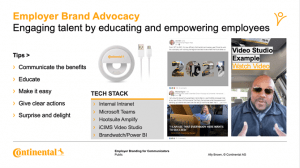3 ways to help workers invest in your brand purpose
Here’s how communicators can reinforce belief in a mission beyond profits–and help fatigued workers reengage.

Employees now expect leadership to step up and speak authentically about issues like corporate citizenship, social justice and even workplace wellness.
Here’s how communicators can help exceed those expectations and energize their colleagues:
1. Seize the storytelling opportunity.
“Don’t just be a messenger, be a leader,” says Katherine Cheng, head of global and community impact at Expedia in a recent Ragan Training video. “Communicators have an opportunity right now to help make the world a better place.”
Why is this such an opportunity for communicators, in particular?
“I believe in the power of storytelling—and nobody does it better than communicators,” she explains. “They know how to articulate stories around social impact in a way that’s meaningful, emotional and more than just a business imperative. Without the storytelling piece, you can’t really inspire and activate people around social impact issues—including your employees.”
2. Align with your business and people.
“The surest way to fail is to engage in lip service,” Cheng says. “Avoid that by being strategic so you can have a real impact. In other words, be precise. Instead of chasing after any issue, align with those that fit your [business] purpose.”
For example, her team at Expedia ensures the two align by tying to travel.
“The post-hurricane work that we’ve done in the Caribbean certainly fits,” she says. “So do our sustainable travel initiatives with UNESCO. We have a responsibility and opportunity to speak to travelers about issues like safe travel and also race equity in various travel destinations.”
Cheng’s specifically referencing initiatives such as Expedia’s Emergency Accommodations Portal, and Expedia’s recent partnership with UNESCO in promoting sustainable tourism and heritage conservation through a joint Sustainable Travel Pledge.

3. Empower and inspire your workforce.
Employees must feel engaged and passionate about social impact programs if they’re to be successful, according to Cheng.
“If you can’t get your employees inspired, you’re not going to have much success sharing your social impact story outside of the organization,” she says.
Her advice: “Use more video when sharing your social impact story internally. Show real people, not just ‘the facts.’ Capture the people involved in your social good initiatives. Real people help bring it to life, especially if it’s authentic, gritty and not overly scripted.”
Cheng adds that employees need one key ingredient before they’ll engage or share.
“It’s all about trust,” she says. “Trust gives them a foundation to help share and tell your social impact story,” she says. “You only get that if you invite them into the process, ask them what programs they’re interested in—and then act on those that fit your [business] purpose.”
Brian Pittman is the Dean of Ragan Training and a Ragan Communications event producer. For more information about Ragan Training, contact brianp@ragan.com.








Well said. Concur that Trust is the key to much loyal and engaged employees. Genuine storytelling is an amazing conversation starter. It boosts morale and inspires staff. A happy engaged staff will speak highly about the company. Staff is the best most affordable credible Public Relations resource any organization can have.